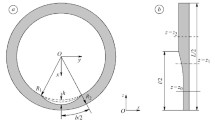Summary
It is shown that the best upper bounds to the load in direct extrusion when the fault known as piping is anticipated are less than the best upper bounds obtainable by the use of similar deformation patterns, when piping is assumed not to be going to occur. A similar approach is made to the case in which a short slug is pierced by two equal size punches and which results in faults at the container wall; this instance is important because it is analogous to the new method by which gudgeon pins are formed.
Similar content being viewed by others
References
Johnson, W., J. Mech. Phys. Solids 5 (1957) 202.
Wang, A. J., Chinese J. Mech. 1 (1957) 95.
Hill, R., Mathematical Theory of Plasticity, Clarendon Press 1950.
Johnson, W., Proc. Inst. Mech. Engrs (1958) (to be published).
Johnson, W., J. Mech. Phys. Solids (1958) (to be published).
Johnson, W., P. B. Mellor and D. M. Woo, J. Mech. Phys. Solids 6 (1958).
Johnson, W., J. Mech. Phys. Solids 1 (1953) 265.
Author information
Authors and Affiliations
Rights and permissions
About this article
Cite this article
Johnson, W. An elementary consideration of some extrusion defects. Appl. sci. Res. 8, 52–60 (1959). https://doi.org/10.1007/BF00411738
Received:
Issue Date:
DOI: https://doi.org/10.1007/BF00411738




